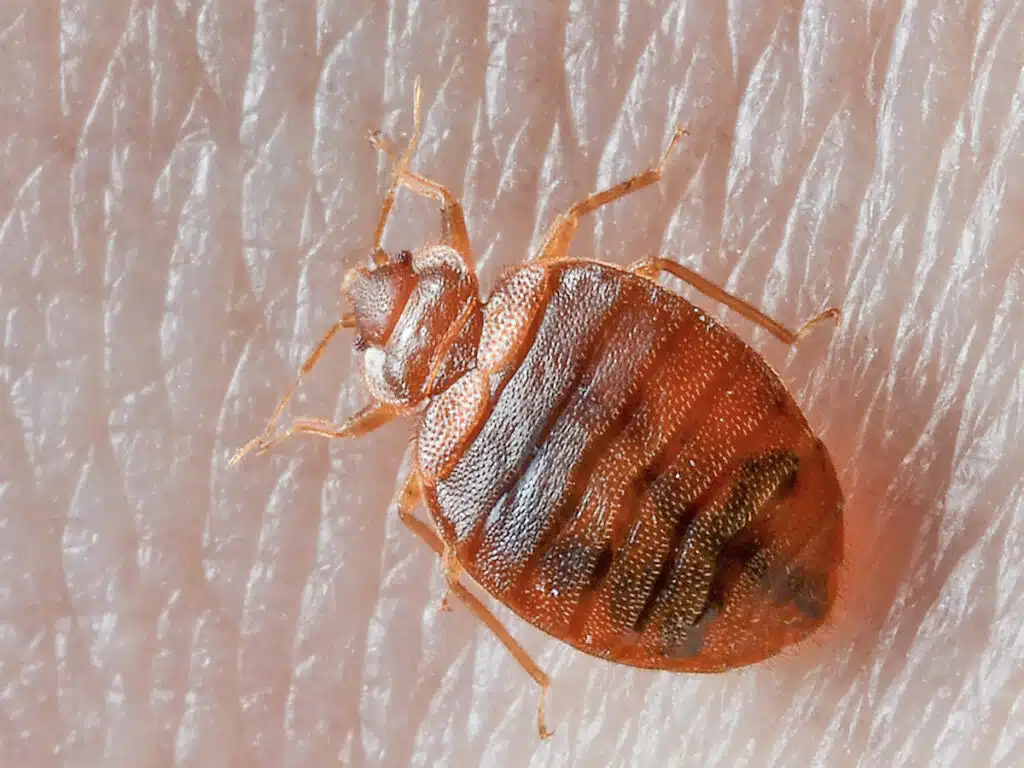

While bed bugs can bite anywhere on the body, they tend to go for areas where the skin is thinner and exposed during sleep. The most common bite locations include the face, neck, arms, hands, and legs. These areas have easy access to blood vessels, making them perfect feeding spots.
Bed bugs are also drawn to the warmth and carbon dioxide we emit while sleeping, which is why they tend to bite areas closest to the head and torso. Unlike other biting insects, they don’t burrow into the skin. They just pierce the surface, feed, and retreat to their hiding spots in places like mattresses, box springs, and upholstered furniture.
Bed bugs tend to target areas of the body where the skin is thinner and blood vessels are closer to the surface, such as the face, neck, hands, and arms. These exposed skin areas provide easier access for bed bugs to suck blood. Additionally, bed bugs are attracted to body heat and carbon dioxide, which are more concentrated around the head and torso during sleep. This combination of factors explains why bed bugs often bite in these specific locations rather than areas covered by clothing.

Bed bugs are tiny insects that survive entirely on human blood, as well as that of other warm-blooded animals. Despite their size, they’re clever little hiders, squeezing into the smallest spaces such as behind wallpaper, along mattress seams, and deep inside furniture. Because of their flat shape, they can go unnoticed for a long time. Bed bugs also travel surprisingly well, hitching a ride on clothing, bedding, luggage, or personal belongings without you even realising.
You can encounter bed bug bites almost anywhere people rest or sleep, not just in the home. Hotels, hostels, and short-term rentals are common places where they spread, especially if rooms share walls or cleaning equipment. Public transport, offices, cinemas, and apartment buildings can also become affected as bed bugs move easily from one area to another.
It’s important to remember that cleanliness has nothing to do with whether bed bugs appear, they can thrive in spotless homes and luxury hotels just as easily as anywhere else.
The dead giveaway for bed bug bites is their distinctive pattern. Unlike spider bites, which are usually isolated, or mosquito bites, which have a random pattern, bed bug bites often appear in clusters, zigzag patterns, or straight lines.
Bite reactions can vary depending on skin type:
Not everyone reacts the same way to bed bug bites. Some people develop red, itchy welts or small bumps, while others show no visible reaction at all. The itching usually appears a few hours after being bitten and can last for several days. In more sensitive individuals, bites may cause swelling or mild allergic reactions. Because reactions vary so much, it’s often hard to tell if bed bugs are the cause just by looking at the bites alone.
Bed bug bites often appear in distinctive patterns such as clusters, straight lines, or zigzags. This occurs because a single bed bug may feed multiple times during one feeding session, moving slightly between bites to find a suitable blood vessel. Recognising these bite patterns can help differentiate bed bug bites from other insect bites, which are often more random or isolated.
See our guide on what bed bug bites look like.
The severity and visibility of bed bug bite reactions can vary depending on the location of the bite. For example, bites on the face and neck may be more noticeable due to thinner skin and increased sensitivity, while bites on the arms or legs might be less visible or cause milder reactions. Individual sensitivity also plays a role, with some people experiencing more intense itching or swelling in certain areas.
Some common bite locations such as the back, scalp, or behind the ears can be difficult to inspect without help. To check these areas, use a mirror or ask someone you trust to assist in looking for bite marks or red welts. Early detection of bites in these less visible spots can be crucial in identifying a bed bug infestation before it becomes severe.
Bed bugs are nocturnal creatures, meaning they are most active at night while their hosts are asleep. However, in severe infestations, they may bite during the day if food is scarce.
While bed bugs cannot bite through most clothing because their mouthparts aren’t long enough to penetrate fabric, exposed skin remains vulnerable to bites. Wearing long-sleeved pyjamas or loose clothing can reduce the amount of exposed skin and thus minimise potential bite areas. However, bed bugs will still target any uncovered skin, so clothing alone cannot guarantee full protection. It’s important to combine protective clothing with other preventive measures to reduce the risk of bed bug bites.
There are loads of pesky critters that love feeding on your skin, so it’s important to know the difference between bug bites. Here’s a quick list to help figure out what bugs are in your bed:
If you’re waking up with unexplained bug bites and spotting other signs like blood stains on sheets or a musty smell, it could mean a bed bug infestation.

Ever wondered how a bed bug infestation gets out of hand so quickly? It’s all down to how fast the bedbug life cycle is. From the moment they hatch, they’re on the hunt for their first meal—meaning bedbug bites start sooner than you’d think!
Tiny, white, and about the size of a grain of salt, bed bug eggs are nearly impossible to see. They’re usually tucked away in mattress seams or sticking to the back of picture frames, making them hard to spot.
Once they hatch, baby bedbugs (called nymphs) are pale and see-through, but don’t be fooled. They’re only pales because they haven’t had their first taste of blood yet. Young bedbugs bite just as much as adult bedbugs. As nymphs grow, they shed their skin five times, a good clue to look for.
Fully grown bedbugs are reddish-brown and about the size of an apple seed. A single female can lay up to 500 eggs in her lifetime, which is why a few bedbugs can quickly spiral into a major infestation. More bedbugs around mean more bedbug bites.

Recognising where bed bugs bite can be key to catching them early, before an infestation takes hold. These pests can multiply rapidly, making prompt action vital to keep the problem under control.
For the most reliable way to banish bed bugs, professional heat treatment stands out as the top choice. At ThermoPest, we specialise in expert solutions tailored to your needs. Intense heat wipes out bed bugs, their eggs, and nymphs in a single sweep, penetrating even the trickiest hiding spots like bed frames, upholstered furniture, and plug sockets. While encasing your mattress in a plastic bag can trap and kill some bed bugs, it won’t fully solve the issue.
Sealing your mattress also offers the bonus of giving your skin a much-needed respite. Once the bed bugs are eradicated, give your mattress a thorough clean—use a firm brush to scrub the seams and dislodge any lingering eggs or bugs. Follow up by hoovering the mattress and washing all bedding in hot water to ensure a fresh, pest-free sleep.
If you’ve noticed bite marks, rust-coloured stains on your bedding, or a musty odour, don’t wait—contact our bed bug experts today. We’ll help you take care of those pesky bugs so you can sleep bite-free again.
Leading experts in bed bug control
Guaranteed quick and rapid responses to urgent infestations
For ongoing problems, use our preventative contracts
Bed bugs predominantly bite areas of skin that remain exposed while you sleep. Common sites include the face, neck, hands, arms, and shoulders. Unlike some pests, bed bugs lack the mouthparts to bite through fabric, so they generally do not burrow under tight clothing or duvets.
Yes, if clothing is loose, they can crawl underneath to reach the skin.
Yes. These areas are often bitten because they are usually uncovered during sleep.
Yes, especially in large cities — hospitals, hostels, and hotels often report infestations due to high turnover of people.
Call us on 0808 189 2310 – or complete our quote form below.
Speak to a bed bug expert today!
Enter Your Details To Request A Call Back
Enter Your Details To Request A Call Back
Enter Your Details To Request A Call Back
Enter Your Details To Request A Call Back
Enter Your Details To Request A Call Back
Enter Your Details To Request A Call Back